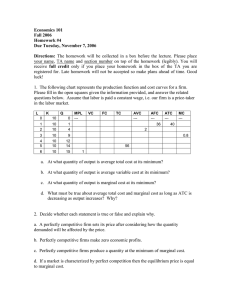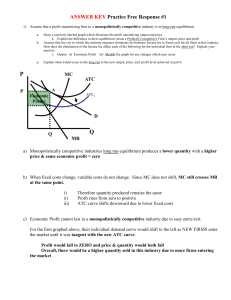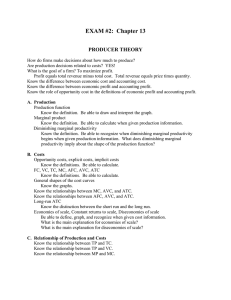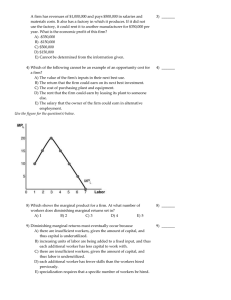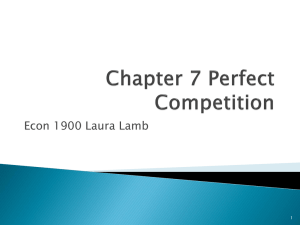Economics 101 Fall 2006 Answers to Homework #4 Due Tuesday, November 7, 2006
advertisement
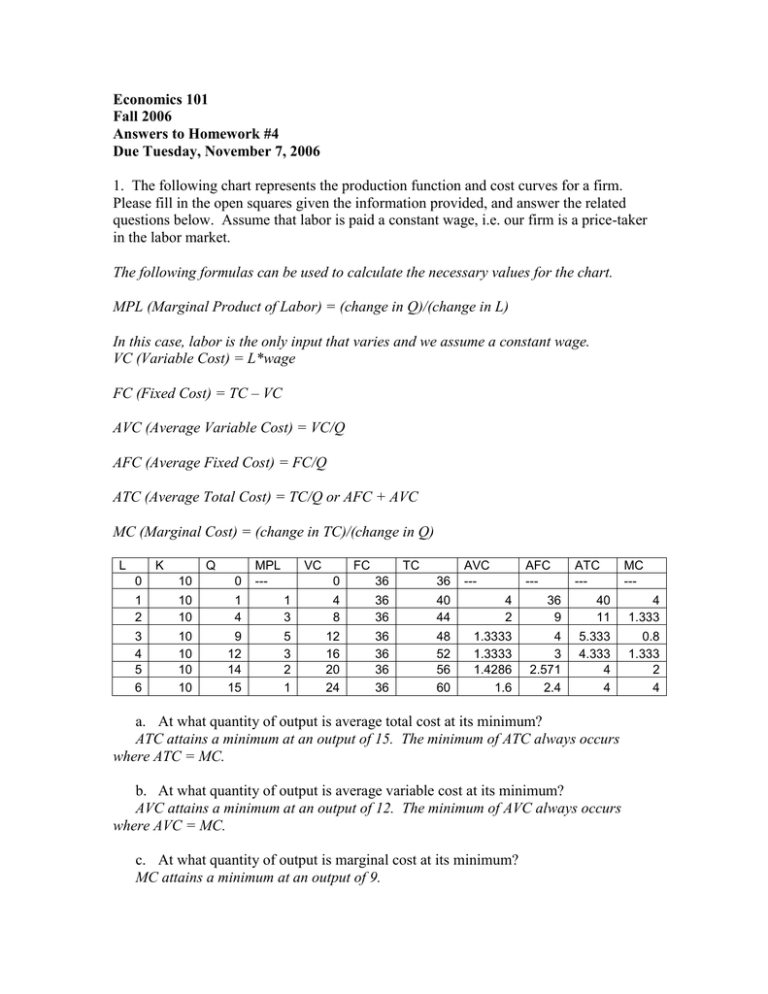
Economics 101 Fall 2006 Answers to Homework #4 Due Tuesday, November 7, 2006 1. The following chart represents the production function and cost curves for a firm. Please fill in the open squares given the information provided, and answer the related questions below. Assume that labor is paid a constant wage, i.e. our firm is a price-taker in the labor market. The following formulas can be used to calculate the necessary values for the chart. MPL (Marginal Product of Labor) = (change in Q)/(change in L) In this case, labor is the only input that varies and we assume a constant wage. VC (Variable Cost) = L*wage FC (Fixed Cost) = TC – VC AVC (Average Variable Cost) = VC/Q AFC (Average Fixed Cost) = FC/Q ATC (Average Total Cost) = TC/Q or AFC + AVC MC (Marginal Cost) = (change in TC)/(change in Q) L K Q 0 10 0 1 2 10 10 1 4 3 4 5 6 10 10 10 10 9 12 14 15 MPL --- VC FC TC AVC --- AFC --- ATC --- MC --- 0 36 36 1 3 4 8 36 36 40 44 4 2 36 9 40 11 4 1.333 5 3 2 1 12 16 20 24 36 36 36 36 48 52 56 60 1.3333 1.3333 1.4286 1.6 4 3 2.571 2.4 5.333 4.333 4 4 0.8 1.333 2 4 a. At what quantity of output is average total cost at its minimum? ATC attains a minimum at an output of 15. The minimum of ATC always occurs where ATC = MC. b. At what quantity of output is average variable cost at its minimum? AVC attains a minimum at an output of 12. The minimum of AVC always occurs where AVC = MC. c. At what quantity of output is marginal cost at its minimum? MC attains a minimum at an output of 9. d. What must be true about average total cost and marginal cost as long as ATC is decreasing as output increases? Why? When ATC is decreasing, MC is less than ATC. This is because the cost of producing each additional unit, represented by marginal cost, is less than the average cost of production for all the units already produced, represented by average total cost. So when the cost of producing the next unit is less than the average unit cost, then the average must fall when this next unit is produced. So ATC must decrease when MC is less than ATC. 2. Decide whether each statement is true or false and explain why. a. A perfectly competitive firm sets its price after considering how the quantity demanded will be affected by the price. False, a perfectly competitive firm acts as a price-taker. It believes that its actions have no impact on the equilibrium price. The firm takes the price given by the market and chooses quantity to maximize profit. b. Perfectly competitive firms make zero economic profits. True, if a firm in a competitive market were making positive economic profits then other firms would enter that market, thus decreasing the profits until they reached zero. c. Perfectly competitive firms produce a quantity at the minimum of marginal cost. False, competitive firms produce at the minimum of average total cost. d. If a market is characterized by perfect competition then the equilibrium price is equal to marginal cost. True, this fact is generated by profit-maximizing behavior in a price-taking context. If a firm takes a price as given, then it will produce up to the point where the next unit would be unprofitable to produce. That point is where price = marginal cost. 3. The market for bobble-head dolls is characterized by perfect competition. This characterization implies that firms and consumers are price-takers. Furthermore, there is free entry and exit into the market in the long run and all firms are identical in terms of their technological capabilities. Thus the cost function as given below for a representative firm can be assumed to be the cost function faced by each firm in the industry. TC = Qs2 + 10Qs + 100 MC = 2Qs + 10 Aggregate demand in this market is given by P = 1000 – Qd a. What will be the equilibrium price in this market? Firms produce where ATC = MC. First find ATC by dividing TC by Q. ATC = Q2/Q + 10Q/Q + 100/Q = Q + 10 + 100/Q Now set ATC = MC Q + 10 + 100/Q = 2Q + 10 100/Q = Q 100 = Q2 10 = Q Now plug this Q into the MC function. MC = 2(10) +10 MC = 30 In a perfectly competitive market, price = MC, therefore, price = 30. b. What will be the output of each firm? Q = 10, This was solved for in a. c. How many firms will exist in the long-run? Plug the equilibrium price of 30 into the aggregate demand curve. 30 = 1000 – Q Q = 970 Thus, the aggregate quantity demanded is 970. We know that each firm provides 10, so the number of firms is found by dividing 970 by 10. 970/10 = 97 Now, suppose that the popularity of bobble-head dolls falls. d. In the short-run will the firms in the market earn profits, earn losses, or break even? Why? In the short-run firms will earn economic losses. If the popularity of bobble-head dolls falls then the demand curve will shift in, and the equilibrium price will decrease. With the same costs, firms now earn losses. e. In the long-run will the number of firms in the market increase or decrease? The number of firms in the market will decrease. Firms are now earning losses, thus some firms will leave the market. This causes the aggregate supply curve to shift in, raising the equilibrium price. This process continues until firms are again earning zero economic profits. f. What will be the long-run equilibrium price now? The long-run price will be the same as before. (Hint: You don’t need that new demand curve to answer these questions.) Consider an alternative scenario where the technology available for producing bobblehead dolls improves. This causes a change in the cost functions. The new cost functions are given by, TC = Qs2 + 5Qs + 100 MC = 2Qs + 5 g. What will be the new equilibrium price? The idea is given in the answer to a. Math below. ATC = Q2/Q + 5Q/Q + 100/Q = Q + 5 + 100/Q ATC=MC, Q + 5 + 100/Q = 2Q + 5 100/Q=Q, Q2 = 100, Q = 10 Plug this into MC, MC = 2(10) + 5 = 25, price = 25 h. How much will each firm produce? As found in g, Q = 10
